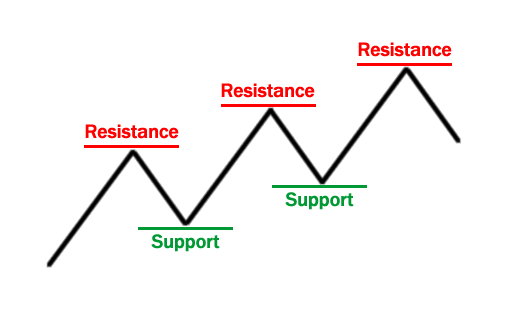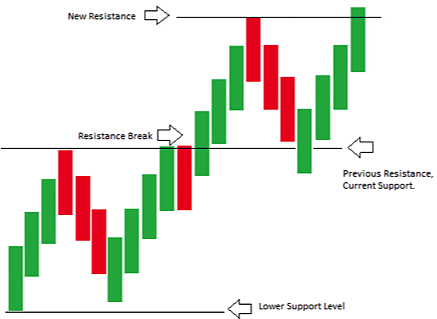Support and Resistance_3
Post on: 16 Март, 2015 No Comment

The concept of support and resistance on a share price chart is important.
You are here: Technical Analysis > Support and Resistance
Introduction
Figure 1
Support and Resistance
Remember that on a monthly candlestick chart, each candle summarises the price action in a whole month — for some basic information about candlesticks, go here.
On this chart, the red line at the horizontal price level labeled 1 (at about $12) indicates a resistance level on the chart. The price was stuck below this level over many months until it broke above it in mid-2004.
Conversely, the green line at the horizontal price level labeled 2 (at about $24) indicates a support level on the chart. Once the price had moved above this level in late 2005, it came back down close to that level on several occasions in 2006, but managed to stay above it.
What is resistance ?
In simplistic terms, a resistance level forms and becomes apparent on a price chart because there is reluctance amongst traders and investors to hold the stock above the resistance level. It might be a whole number of dollars (such as $12.00).
On a price chart, a resistance level on the chart appears to be a ceiling for the price, where the price rises to the ceiling and then falls away, as though the ceiling is a concrete barrier that is preventing the price from rising.
There are many reasons why the market sentiment might cause a price to be stuck below the resistance level. One of them is simply a broad view that the stock is not worth any more than that amount. In this case, whenever the price rises close to an established resistance level, many traders will take profits in the belief that the price is about to fall again.
In many cases, there comes a point where the sellers in the market who have been selling the stock up to the resistance level have all gone. Once this happens, the only sellers are then at prices above the resistance level, and the price can move up to above that level. Once this situation seems to be confirmed, then more buyers will come into the market, and even people who were selling in the past might now become buyers to buy back into the stock while it is rising (they will be afraid of missing out on higher prices — the emotions of fear and greed at play).
What is support ?
A support level forms and becomes apparent on a price chart because there is general agreement amongst traders and investors that a stock is worth more than a particular price point — the specific support level. On a price chart the support level appears to be a floor under the price, such that as the price falls to this level, and then rebounds up and away from the level.
As with resistance described above, there are many reasons why market sentiment might cause a share price to remain above a specific price level.
A trendline is also support
A rising trend line (as shown with the dashed line in the above sample price chart and labeled 5) also seems to act as a floor under the price, and is considered a support line. As the price rises, the rising trendline appears to act as a floor and the price appears to bounce up off the support line.
Change in polarity
It is common for a specific resistance level on a price chart to eventually become a support level. This happens because of the psychology of the investors and traders, and simply reflects their sentiment. That is, once the share price has broken above a resistance level, sentiment often switches so that the same level is then the bottom level at which people will buy.
Fat pencil
When identifying and drawing a support or resistance level on a price chart, it is sometimes useful to draw it with a fat pencil. The level is often a precise price point; but often it is a wider zone or range of prices.

Past levels become future levels
One phenomenon that is often observed is that a support or resistance level in the past will also be a support or resistance level in the future. In some cases this is due to the psychological impact that a number of investors had bought at the previous level, only to see the price fall away. Their desire is to recoup their losses by simply selling the next time the price reaches the same level. So, when the price rises again to that level, they will all be queuing up to sell, and this selling pressure can be enough to stop the price rise.
Chart patterns
Many chart patterns such as triangles, pennants, wedges, flags, double tops and bottoms, and so on, all have price ranges on the chart where a straight line can be drawn across the chart as either a support line, or resistance line. In some chart patterns there is one of each type that envelopes the price action.
Which charts? daily, weekly, monthly?
And shares, commodities, currencies?
When looking for levels of support and resistance, should we be viewing daily charts? or weekly? or what? Well, these observations apply to price charts of any period and any financial market. That is, they apply to share prices, CFDs, commodities, currencies, etc. and they will apply to daily, weekly, monthly, quarterly, yearly charts. And they will also apply to intra-day charts (eg. hourly charts, 30-minute charts, 10-minute charts, etc.). Because of the underlying concept, it applies across all these variations.
However! You might find that the most accurate placement of a support or resistance line is done on daily charts, using the body of the candle to assist with line placement. This is because the most important price each day is the closing price, which is that value where the professional traders are happy to commit to a price for the overnight non-trading period. On a weekly and monthly chart, the daily close prices are not shown.
How is all this useful?
Price charts summarise the underlying opinions
Once we understand the notion of support and resistance levels on a price chart we can go hunting for them, and draw them in on the chart, and project them forward in time. At some point in time they might fail; but in the meantime they do provide a good indication of likely price action. One good application is to apply a Stop Loss just below a recent support level. Price will normally be expected to bounce off a support level, but if it happens to fall through it, then the price might continue falling so we should look at exiting a position.














